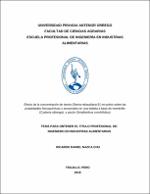Efecto de la concentración de stevia (Stevia rebaudiana B.) en polvo sobre las propiedades fisicoquímicas y sensoriales en una bebida a base de membrillo (cydonia oblonga) y yacón (smallanthus conchifolius)

View/
Download
(application/pdf: 1.041Mb)
(application/pdf: 1.041Mb)
Date
2019Author(s)
Nazca Chu, Ricardo Daniel
Metadata
Show full item recordAbstract
En el presente estudio se evaluó el efecto de la concentración de stevia
(Stevia rebaudiana B.) en polvo sobre la acidez titulable, viscosidad, color
y aceptabilidad general en una bebida a base de membrillo (Cydonia
oblonga) y yacón (Smallanthus conchifolius). Se aplicaron tres
tratamientos, con el uso de membrillo y yacón como materia prima; que
fueron seleccionados, lavados, cortados, estandarizados,
homogenizados, pasteurizados, enfriados, envasados y almacenados. En
el primer tratamiento se utilizó 0.5% de stevia en polvo, el segundo
tratamiento se utilizó 1% y en el tercer tratamiento se utilizó 1.5%;
evaluando acidez titulable, color, viscosidad como variables paramétricas.
Sensorialmente se evaluó la aceptabilidad general con treinta jueces no
entrenados, utilizando una escala hedónica de nueve puntos. Los análisis
estadísticos se realizaron a un nivel de confianza del 95%, la prueba de
Levene modificada demostró homogeneidad de varianzas para las
variables paramétricas. El análisis de varianza mostró diferencias
significativas (p<0.05) en la viscosidad aparente, la cual aumentó al
incrementar la concentración de stevia en polvo, al igual que en la acidez
titulable, el análisis de varianza mostró diferencias significativas , la cual
aumentó al incrementar la concentración de stevia en polvo. En el color,
para L*, a* y b* existió efecto significativo (p<0.05) de la concentración de
stevia en polvo en la bebida a base de membrillo y yacón. La prueba de
Duncan determinó que la concentración 1.5% de stevia en polvo presentó
mayor valor de viscosidad (15.34 mPa.s). La pruebas no paramétricas
para la evaluación sensorial aplicadas fueron Friedman y Wilcoxon
determinando que el mejor tratamiento en aceptabilidad fue 1.0% de
concentración de stevia en polvo con un promedio de 7.10 y moda 7
correspondiente a la percepción “Me agrada moderadamente”. In the present study, the effect of the stevia (Stevia rebaudiana B.) powder
concentration on the titratable acidity, viscosity, colour and general
acceptability in a quince-based drink (Cydonia oblonga) and yacon
(Smallanthus conchifolius) was evaluated. Three treatments will be
applied, with the use of quince and yacon as raw material; They were
selected, washed, cut, standardized, homogenized, pasteurized, cooled,
packed and stored. In the first treatment, 0.5% of powdered stevia was
eliminated, the second treatment was eliminated by 1% and in the third
treatment 1.5% was eliminated; Evaluating titratable acidity, color, viscosity
as parametric variables. Sensorially, the general acceptability was
evaluated with thirty untrained Thursdays, using a nine-point hedonic
escalation.He statistical analyzes were performed at a confidence level of
95%, the modified Levene test showed homogeneity of variances for the
parametric variables. The analysis of variance showed significant
differences (p <0.05) in the apparent viscosity, which increased when
increasing the concentration of powdered stevia, as in the titratable acidity,
the analysis of variance showed significant differences, which increased
when increasing the concentration of stevia powder. In color, for L *, a *
and b * there was a significant effect (p <0.05) of the concentration of stevia
powder in the quince-based drink and yacon. The Duncan test determined
that the 1.5% concentration of stevia powder had a higher viscosity value
(15.34 mPa.s). The non-parametric tests for sensory evaluation applied
were Friedman and Wilcoxon determining that the best treatment in
acceptability was 1.0% concentration of stevia powder with an average of
7.10 and 7 corresponding to the perception ““I like it moderately
Collections
- Industrias Alimentarias [152]

